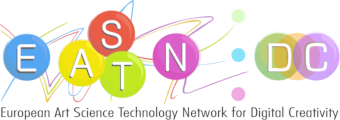Summary
This paper focuses on the quality of user experience in artistic interactive installations that combine music, dance, interaction, and social events. It presents the research, development, and evaluation of two artistic installations implemented as part of an Integrated Master's degree Thesis in the Department of Product and Systems Design Engineering of the University of the Aegean.
Extended Abstract
The present paper is focusing on the evaluation of two artistic installations to draw conclusions regarding user experience from both a technological and an aesthetic point of view. The works, presented and analyzed here, are based on modern technology which is developed in the first case via an interactive installation that combines the performing arts of dance with holographic projection and is entitled "The other me", and in the second case via an interactive audiovisual installation that combines live music performance and animated graphics with the use of arduino, and is entitled 'imusicWALL'.
The first work is an artistic digital installation that enables the audience to watch a dance performance in real time. It takes place in a specially designed interior space, which covers the needs of the installation with main components being the computer, speakers, projector and original elements designed for the specific application (panels, pyramid and other decorative elements).The installation enables a passive interaction of the work with the public, inviting them to move in the space to come up close with, with the real dancer and to watch the digital holographic projection while walking around the perimeter. After the completion of the digital part of the project follows the creation of the choreography of the physical model. More specifically, the physical model is based on guided improvisation with the difference that it now knows the existence of the digital model.
The second project is an interactive installation that offers an audiovisual experience to the guests / participants of a live music performance. It is a modular spatial installation, which requires an "empty" interior space or an existing specially designed one, in which the necessary media objects can be installed (projector, speakers, seats, computer, midi and led strips). In addition, the participation of a musician / performer who directs the music and the image live (video projection) in real time is fundamental, as well as the presence of an audience, which can intervene with its movements, causing some changes in the image (video projection). These changes include graphics and messages that push the audience to participate, with expressive movement, perhaps dance. At the same time, the video projection emerges as a result of the collaboration of the musician and the participating audience.
During the evaluation of the above installations, the dynamics of technology within contemporary art are analysed and presented: According to the types of interactivity presented by Cornock and Edmonds (static, dynamic-passive, dynamic-interactive, dynamic-interactive varying) both installations are considered dynamic-interactive varying, as they allow modifications from humans as well as from a software program. Respectively, according to the 5 dimensions interaction theorized by Gillian Crampton Smith and Kevin Silver (1D words, 2D visual representations, 3D physical objects / spaces, 4D time, 5D behavior), in the first installation four of the five dimensions of interactivity are observed, while in the second the three. Finally, according to the types of interactivity presented by Yvonne Rogers et al (guidance, conversation, manipulation, exploration), in the first installation the exploration is included, while in the second are included only the manipulation and the exploration.
In addition, the installations were prototyped and then the behavioral and physiological measures, the self-report measures and the success of the work were examined. The results of the evaluation showed that both projects proved to be understandable and simple to use, evoked feelings of curiosity, intensity and fun, the overall atmosphere was dynamic and harmonious and finally in terms of the technology’s performance, it proved to be fully functional. According to the results of the evaluation of the artistic installations, the users considered the experience positive and attractive and led to some issues for further consideration regarding the installation of the systems and the user experience.
Back
“Reflections: Bridges between Technology and Culture, Physical and Virtual”
is supported by:






